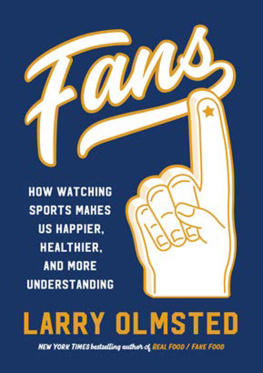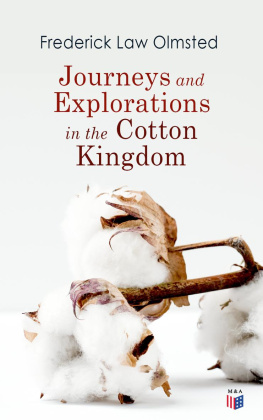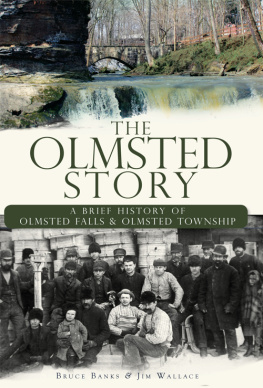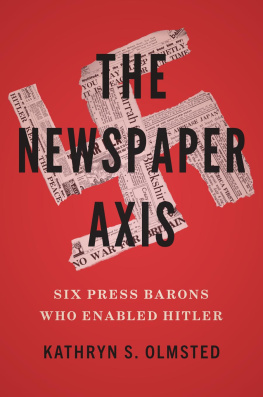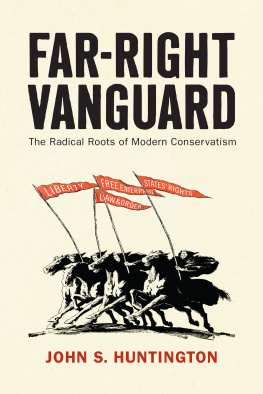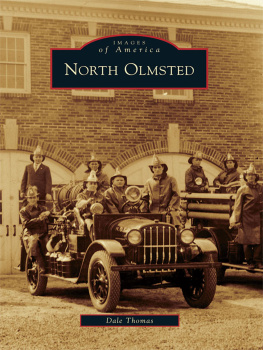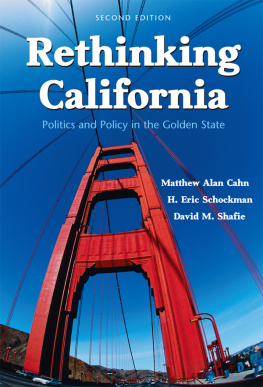Right Out of California
ALSO BY KATHRYN S. OLMSTED
Real Enemies: Conspiracy Theories and American Democracy, World War I to 9/11 (2009)
Red Spy Queen: A Biography of Elizabeth Bentley (2002)
Challenging the Secret Government: The Post-Watergate Investigations of the CIA and FBI (1996)

2015 by Kathryn S. Olmsted
All rights reserved.
No part of this book may be reproduced, in any form, without written permission from the publisher.
Requests for permission to reproduce selections from this book should be mailed to:
Permissions Department, The New Press, 120 Wall Street, 31st floor, New York, NY 10005.
Published in the United States by The New Press, New York, 2015
Distributed by Perseus Distribution
LIBRARY OF CONGRESS CATALOGING-IN-PUBLICATION DATA
Olmsted, Kathryn S.
Right out of California : the 1930s and the big business roots of modern conservatism / Kathryn S. Olmsted.
pages cm
Includes bibliographical references and index.
ISBN 978-1-62097-139-0 (e-book)
1. CaliforniaPolitics and government20th century. 2. CaliforniaEconomic conditions20th century. 3. ConservatismCaliforniaHistory20th century. 4. Labor disputesCaliforniaHistory20th century. 5. Agricultural industriesPolitical activityCaliforniaHistory20th century. 6. BusinessmenPolitical activityCaliforniaHistory20th century. 7. Business and politicsCaliforniaHistory20th century. 8. Social changeCaliforniaHistory20th century. 9. Depressions1929California. 10. New Deal, 19331939California. I. Title.
F866.O483 2015
320.5209794dc23
2015013928
The New Press publishes books that promote and enrich public discussion and understanding of the issues vital to our democracy and to a more equitable world. These books are made possible by the enthusiasm of our readers; the support of a committed group of donors, large and small; the collaboration of our many partners in the independent media and the not-for-profit sector; booksellers, who often hand-sell New Press books; librarians; and above all by our authors.
www.thenewpress.com
Composition by Westchester Books Group
This book was set in Goudy Standard
Printed in the United States of America
10 9 8 7 6 5 4 3 2 1
For Eric
CONTENTS
Right Out of California
When Herbert Hoover went through his mail in the summer of 1933, he grew steadily more furious about the policies of the man who replaced him in the White House. Ensconced in his modernist mansion in the hills above Stanford University, where he had retreated after his recent defeat, Hoover wrote one bitter letter after another to his fellow Western businessmen about the shortcomings of Franklin Roosevelts New Deal. Roosevelt trafficked in constant misrepresentations and illusions, Hoover seethed; the presidents New Deal policies would lead to the destruction of the savings of the people and the impoverishment of the country. In fact, Roosevelt was just using the Depression as an excuse for imposing socialism under new euphemistic phrases.
Contemplating Roosevelts policies, Hoover lamented the end of the gold standard, the beginning of unemployment insurance, and the ways the industrial recovery program terrorized Americans. Referring to Roosevelts agricultural price supports, Hoover complained that the country was trading away its heritage of liberty for a fictitious price of wheat.
Yet Hoover benefited from government programs that set fictitious prices. Among Hoovers many investments were four large California ranches, including one with 240 acres of cotton fields. And Hoovers son Allan, the ranch manager, was eligible to become one of hundreds of thousands of cotton growers who signed subsidy contracts with the federal government.
Many wealthy, conservative California growers joined Hoover in pocketing the Agricultural Adjustment Administrations checks. Unlike Hoover, some of them publicly admitted they were happy to do so. Philip Bancroft, a prosperous fruit grower and Republican Party activist, wrote admiringly to the secretary of agriculture of his enthusiastic appreciation of the splendid work that you and the entire Administration have been doing on behalf of our industry.
Western growers also welcomed other New Deal programs, including the loans of the Farm Credit Administration and infrastructure programs that promoted agriculture. The Public Works Administration, the Reconstruction Finance Corporation, and the Bureau of Reclamation built dams and irrigation systems for California growers, including massive new canals through the states rich agricultural valleys. Agribusiness leaders had benefited from federal irrigation and transportation spending for decades, and they greeted the New Deals expansion of these programs with enthusiasm. But the New Deal differed from those older government programs because, unlike the big-spending Republicans of the nineteenth century, the New Dealers put resources into helping farm owners and into defending organized labor.
For decades before 1933, the federal government had supported management against labor. At a minimum, American companies in the pitched labor battles of the 1870s through the early 1930s could count on the U.S. government to turn a blind eye to employer violence against striking workers. And at times, including the Great Railroad Strike of 1877, the Pullman strike of 1894, and the West Virginia miners strikes of the early 1920s, they The judicial system also assisted big business. The U.S. Supreme Court sided with employers who fired their workers for joining or even sympathizing with unions, and the courts routinely issued injunctions to stop strikes.
Then, in the 1930s, during Roosevelts New Deal, the federal government began to change the ways it intervened in the economy. It started serving labor as well as management. Congress and the Roosevelt administration empowered workers by going so far as guaranteeing their right to join unions. Section 7a of the 1933 National Industrial Recovery Act said that workers shall have the right to organize and bargain collectively through representatives of their own choosing. By 1935, when the National Labor Relations Act superseded Section 7a, the Roosevelt administration was unequivocally protecting industrial workers right to organize and to demand higher wages and better conditions from their employers. It was these New Deal labor policiesparticularly when they helped people with dark skin or relatively radical beliefsthat prompted businessmen to launch a counterrevolution that would continue into the next century.
Ironically, Californians, like other Westerners, knew well what good the federal government could do. The vast expanse of the American West had served, as historian Richard White has written, as the kindergarten of the American state.
The agribusiness barons of California did not just complain about the changes the New Deal brought. They organized. To attack labor, they formed and funded industry groups to lobby local governments to outlaw picketing and imprison union leaders. They hired publicists who branded strikers as Communists and tried to turn the public against them. To combat what they saw as the broader problem of New Deal labor laws, they hired political consultants who understood how to use concerns about cultural changes to turn middle-class Californians against government policies that benefited workers. These conservatives, a new breed of activist, discovered and funded media-savvy, right-wing office seekers who would spread their message.
The new conservatives often connected the economic changes they deplored with the cultural changes they feared. Californians on the political right expressed anxiety that the color line was becoming blurred in the 1930s, as Mexican Americans, Asian Americans, and African Americans moved into spaces and jobs that had previously been off-limits to them. They worried that the traditional, patriarchal family was under siege as women began to take on more economic responsibilities and leadership opportunities. Traditionalists also disliked the emphasis on class struggle in the art and novels of the Depression decadeparticularly in the work of Californians like photographer Dorothea Lange and, most famously, a young novelist named John Steinbeck, who described the desperation and celebrated the resiliency of farmworker families.
Next page

